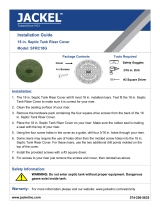
Figure 1
Figure 2
Figure 3
Figure 3A
Instructions for Riser Kits
P/N: 102367 101975 101976 102576 101977 102577 101978 102578 102579 102580 101979 102581 102582 102583 102364
Tools required:
Steps:
Installation must be performed by person possessing mechanical competence.
1.) With the white tape upward, apply approximately 77” of butyl sealant rope
(Figure 3A) around the perimeter of the adapter flange where the riser pipe will
meet the flange (Fig.1) & (Fig. 2), overlapping and kneading the ends of the butyl
rope together to ensure a water-tight seal.
2.) Remove the white tape from the sealant rope and discard the tape.
3.) With the (4) pre-drilled holes upward (Fig. 5) & (Fig. 10), center the riser pipe on
the adapter flange so the gap is even all of the way around. Do not apply
downward pressure while adjusting the gap. When the even gap is achieved,
lightly lower the riser pipe onto the butyl rope. As required, make final adjustment
and apply firm downward pressure to seat the riser pipe into the butyl rope. Apply
the pressure all around the riser pipe every 30 degrees.
4.) Locate the six (6) mounting holes on the inside perimeter of the adapter flange.
Install six (6) screws to attach the riser pipe to the adapter flange. Drive the
screws with the screw tilted upward following the pre-drilled hole until the head
slightly compresses the adapter flange (Fig 3.). When properly tightened there will be
approximately a ¼” gap between the riser flange and the riser pipe (Fig. 4). All six
screws must be visible when complete (Fig. 5).
5.) Repeat steps 1 – 4 for each section for risers 23” tall and greater. NOTE: lower
sections do not have pre-drilled holes, therefore space equally around inner
perimeter.
How to Install
the Safety Barrier
6.) Locate the six mounting slots on the safety barrier (Fig. 6). Insert the
safety barrier into the riser ensuring the six mounting slots align with the 6
screws (Fig 5), (Fig. 6) & (Fig. 7).
7.) Confirm all six slots are engaged with all six screws. While applying slight
downward pressure, rotate the safety barrier clockwise, the direction the
“LOCK ARROW” points. A slight rap with the palm of the hands in the
safety barrier triangular openings will seat the safety barrier in place.
8.) Grasp the openings of the safety barrier and pull upward. It MUST NOT
dislodge from the assembly. If all of the mounting tabs are not engaged
with the screws, remove the safety barrier and repeat step 6 through step
8 until the safety barrier is secure.
CRITICAL SAFETY WARNING: Always securely attach Riser Cover to Riser by installing and tightening the (4)
screws using the appropriate driver tool. Cover security must be checked after each tank servicing. Cover must be
inspected regularly for damage and security. The secondary safety barrier must be securely fastened in place at
all times. The safety barrier must only be removed to gain entry into the tank by a properly credentialed
professional donning appropriate safety gear.
An unsecured cover or secondary safety barrier is a serious safety risk.
Butyl Rope
CAUTION: INSTALLER AND SERVICE PERSONNEL
MUST PLACE THIS GUIDE IN PLASTIC POUCH AND
ENSURE IT IS ATTACHED TO THE SAFETY BARRIER
AFTER INSTALLATION IS COMPLETE SEE FIG. 9
CAUTION: INSTALLER AND SERVICE PERSONNEL MUST PLACE
THIS GUIDE IN PLASTIC POUCH AND ENSURE IT IS ATTACHED TO
THE SAFETY BARRIER AFTER INSTALLATION IS COMPLETE
SEE FIG. 9
Printed on durable
waterproof paper
• Electric Drill
• 5/32” drill bit (carbide tip if septic tank
is concrete)
• #3 Phillips head driver bit
• Utility knife
• Safety glasses
• Gloves
*** Beware of sharp edges when
handling components***
83”
77”
WARNING: FAILURE TO PROPERLY ENGAGE THE SAFTEY BARRIER
WILL DEFEAT THE SAFTEY FEATURE OF THE DEVICE!



